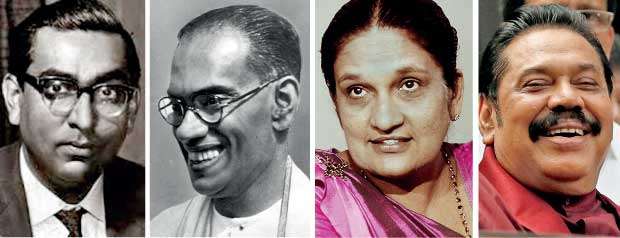A Brief Colonial History Of Ceylon(SriLanka)
Sri Lanka: One Island Two Nations
A Brief Colonial History Of Ceylon(SriLanka)
Sri Lanka: One Island Two Nations
(Full Story)
Search This Blog
Back to 500BC.
==========================
Thiranjala Weerasinghe sj.- One Island Two Nations
?????????????????????????????????????????????????Wednesday, May 9, 2018
Duplicate-Mahinda is not the answer… UNP needs a winning ‘unifier’

“Be yourself, because an original is worth more than a copy” - Unknown quotes
 2018-05-09
2018-05-09In order to defeat the Mahinda Rajapaksa juggernaut, there is one thing the United National Party (UNP) should not do – field a ‘Duplicate Mahinda.’ What is the Mahinda Rajapaksa-candidature looking like? In an election campaign, the one thing one must pay most attention to is the basic brand of the candidature. How does the voter look at the brand? Is there an identifiable brand? Did the planners of the campaign, or the politico-experts, originally plan to brand the Rajapaksa-candidature or did the advertisers do so? Sometimes a brand gets built up without any effort being made to build it. Unlike professional marketing of branded products, like Sunlight for soap or Astra for margarine, political marketing, prior to early 1990s, there was no sophisticated campaign planning. Yet, the 1956 campaign of S.W.R.D. Bandaranaike’s Mahajana Eksath Peramuna (MEP) seemed to have been a coordinated effort without which such a sweeping victory would have been possible.

Bandaranaike, with that campaign in ’56, gave a fantastic brand to the Sri Lanka Freedom Party (SLFP), ‘common man’s party’ and a brand which is valid and applicable even in today’s context of a more sophisticated and tech-savvy public relations environment. That ‘common man’s party’ brand has outlasted its creator’s own assassination, it’s domination by a feudal tyranny such as Sirimavo and Felix Dias Bandaranaike, it’s being decimated by the Rajapaksa clan and its seemingly obliteration under the current leader of the party.
In addition to being branded a cardboard or duplicate-Mahinda, any nationalistic or narrow chauvinistic appeal to the voter would betray the very essence of the UNPSuch a strong branding has been facilitated by its incessant propaganda, despite the SLFP’s numerous and varied flirtations with the not-so-common man. The SLFP leadership, until it fell on the present holder, has been, including the Rajapaksa clan, set up on a feudal platform revolving around a family. Although the Rajapaksa family does not belong to that ‘feudal’ denomination in a classical sense, family rule was the core power centre, so to speak. The great irony of this phenomenon is the ease with which the rank and file of the party accepted this family rule.
The acceptance of the Bandaranaike family could be explained as its founder, S.W.R.D. Bandaranaike hailed from a leading low-country, Govigama family in the nineteenth century. SWRD’s father was the first among many local government servants who served the colonial British regime at the time. Subservience shown by the then populace towards these feudal masters continued towards this family rule even after independence albeit the fact that SWRD was one of the earliest liberals who advocated breakage of the bond between the master and servant, a generations-old practice which was exercised by the Bandaranaike clan before him.
When he launched his new political party on the five-pronged platform of Sanga, Veda, Guru, Govi, Kamkaru, (Buddhist Clergy, Indigenous doctor, school teacher, farmer and worker), so was launched the political party of the ‘common man.’ However, since his assassination by a member of one of the five pillars of his platform, since its takeover by his widow, the SLFP became anything but common man’s party. The widow, Sirimavo with the able assistance of Felix Dias, a Bandaranaike whose participation in politics SWRD never sought, turned the common man’s party into an uncommon man’s party. Yet, its grassroots rank and file clung on to its draconian leaders and their representative henchmen and women at the village level. The theory of Joseph Goebbels, the Nazi Propaganda Minister under Hitler, that an untruth repeated over and over again would become the truth was proven right. Today the common man’s party is really a ‘petty man’s’ party.
While the SLFP was branded the ‘common man’s party,’ the UNP became the ‘rich (uncommon) man’s party.’ One stark reality within the ranks of the SLFP remained its sense of nationalism bordering on chauvinism. This chauvinistic legacy was passed down the line of successive leaderships in the SLFP and the Rajapaksas were the last to be the fortunate recipients of that ignoble inheritance.
However, the Rajapaksas added value to this chauvinism of the party. The thirty-year war with Tamil militants and its conclusion to a gleaming success thanks to devoted and determined efforts of a military and its leadership of the calibre of General Sarath Fonseka was that added value. All of a sudden, the ‘common man’s party’ became a party of patriots. And every other political party was branded unpatriotic! Mahinda Rajapaksa became a devout Buddhist overnight; he started giving Mercedes Benz cars to leading Buddhist monks and followed the R. Premadasa practice of Bana at the Temple Trees on every Poya Day. To paraphrase a cliché of Catholic genre, ‘Mahinda Rajapaksa had become more Buddhist than Arahat Sariputta.’
So cleverly and consistently built was this image of patriot and Buddhist, Mahinda Rajapaksa became unsurpassable on the score of religion and love for the country. In other words, he made it impossible for a duplicate-Mahinda to be constructed in the political arena. It is here, if any of the UNP leaders attempts to float an image of a ‘duplicate-Mahinda’ in order to defeat him or his cohorts such as Gotabaya, Basil or even Chamal in an election, would fall flat. The UNP leadership has drawn its strength not from being fringe-friendly; on the contrary it has drawn its strength, from D.S. Senanayake downwards up to Ranil Wickremesinghe, apart from the majority Sinhalese Buddhists, the Tamils in the North and the estate sector and Muslims scattered all round the country.
For instance, take all the Cabinets from 1947 to date, not a single elected non-UNP/Independent/Federal/TULF/TNA Tamil leader has served any Sri Lankan Cabinet. In the DS Cabinet, the two Cabinet ministers were C. Siththampalam and C. Sundaralingam, both elected as Independent MPs. Later, G.G. Ponnambalam joined the Cabinet not from the Federal Party but from Tamil Congress and both Sundaralingam and Ponnambalam lost their seats in the following elections. The next Cabinet member was Thiruchelvam in Dudley Senanayake’s coalition government from the Federal Party and its leader Chelvanayagam saw to it that the Cabinet minister came from the Senate (non-elective body of government). Sirimavo’s Cabinet in 1970 had a Tamil minister, Chelliah Kumarasuriar, and he too originated from the Senate, not elected. In the 1977 J.R. Jayewardene Cabinet, S. Thondaman from Nuwara Eliya became quite a powerful Cabinet minister. The Northern Tamil was not represented in an overwhelming Sinhalese Cabinet since 1965 – M. Thiruchelvam.
However, after the Presidential system was introduced, since 1982, no candidate has been successful without securing the support of the Tamil vote in the North. The only exception is 2009 Presidential election which was held soon after the war-victory which explains the Tamil vote in the North was not a factor.
If any in the UNP thinks that he or she can outdo Mahinda in Mahinda’s strong suit, then think againThe argument is, as much as Sir John Kotalawela failed miserably at the 1956 general election despite promising more than Bandaranaike for the Sinhalese Buddhist cause, no duplicate-Mahinda will be a successful candidate from the UNP. In addition to being branded a cardboard or duplicate-Mahinda, any nationalistic or narrow chauvinistic appeal to the voter would betray the very essence of the United National Party, a party that represents a united Sri Lanka. Populism and nationalism might well be the political wind that is sweeping across the USA and European continent, the Sinhalese Buddhist vote being divided between the UNP and anti-UNP bloc proportioned on a 35% to 65%, it is highly unlikely to secure the seat of presidency without the Tamil vote in the North and the Muslim vote all over the country.
The scorching Jaffna-sun is indeed having its effects not only on the untiring Tamil working farmers in the North, it is bearing an unchallenged consequence on the electoral landscape in Sri Lanka. The UNP and its new leadership with the younger heads such as Navin Dissanayake and Sajith Premadasa have a formidable challenge. Their bitter battles will be fought not only in the rural hamlets where the unrivalled majority are Sinhalese Buddhists, they will have to predominate the North, hill-country and the East. Minority votes are not only a must; they are the foundation on which any realistic campaign could be built upon.
If any in the UNP thinks that he or she can outdo Mahinda in Mahinda’s strong suit, then think again. When the voter wants to oust Mahinda or his siblings, the voter is looking for an alternative, not a duplicate. Most politicians make this grievous error in judgment. Especially in the sphere of socio-political issues, the voter is extremely sensitive when he makes his choice. Unlike economic issues to which the voter confronts them on a daily and continuously changing circumstance, socio-political issues entrench him over a long period of time. Sensitivity to socio-political issues does not depend on short-term whims and fancies of one or two politicians. Any politician who changes his or her stance on a socio-political issue may not gather more votes from the majority bloc; but if he chooses to trek a different path, he may lose a sizable chunk of the minority costing him the election. That is not an option for either Navin Dissanayake or Sajith Premadasa, if they are planning to contest the next Presidential elections on the UNP ticket.
The writer can be contacted at vishwamithra1984@gmail.com

